新目标九年级英语第五单元教案
- 格式:doc
- 大小:118.50 KB
- 文档页数:12
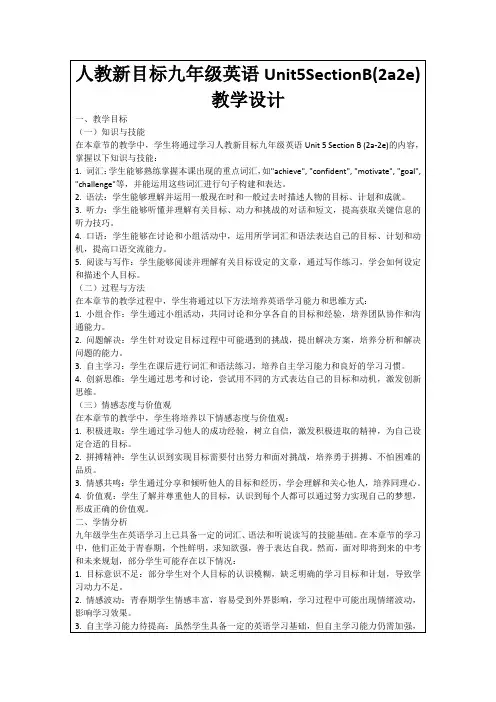
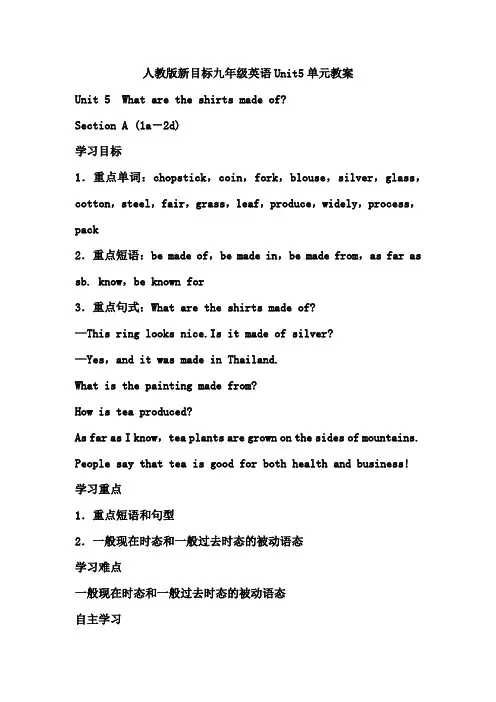
人教版新目标九年级英语Unit5单元教案Unit 5 What are the shirts made of?Section A (1a-2d)学习目标1.重点单词:chopstick,coin,fork,blouse,silver,glass,cotton,steel,fair,grass,leaf,produce,widely,process,pack2.重点短语:be made of,be made in,be made from,as far as sb. know,be known for3.重点句式:What are the shirts made of?—This ring looks nice.Is it made of silver?—Yes,and it was made in Thailand.What is the painting made from?How is tea produced?As far as I know,tea plants are grown on the sides of mountains. People say that tea is good for both health and business! 学习重点1.重点短语和句型2.一般现在时态和一般过去时态的被动语态学习难点一般现在时态和一般过去时态的被动语态自主学习一、预习课本P33-34新单词并背诵,完成下面的汉译英。
1.筷子________ 2.硬币________3.叉子________ 4.衬衫________5.银器________ 6.玻璃________7.棉花________ 8.钢铁________9.展览会________ 10.草地________11.叶子________ 12.生产________13.普遍地________ 14.加工________15.包装________二、认真预习1a-2d找出下列短语和句型。
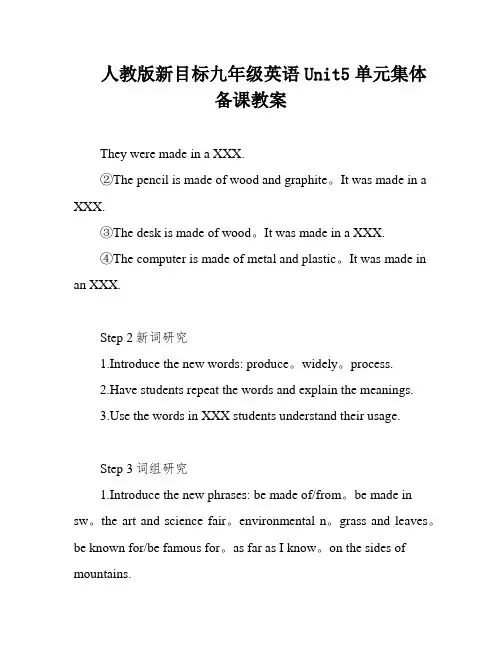
人教版新目标九年级英语Unit5单元集体备课教案They were made in a XXX.②The pencil is made of wood and graphite。
It was made in a XXX.③The desk is made of wood。
It was made in a XXX.④The computer is made of metal and plastic。
It was made in an XXX.Step 2新词研究1.Introduce the new words: produce。
widely。
process.2.Have students repeat the words and explain the meanings.e the words in XXX students understand their usage.Step 3词组研究1.Introduce the new phrases: be made of/from。
be made in sw。
the art and science fair。
environmental n。
grass and leaves。
be known for/be famous for。
as far as I know。
on the sides of mountains.2.Have students repeat the phrases and explain the meanings.e the XXX students understand their usage.Step 4句型研究1.Introduce the sentence patterns: What is the model plane made of。
What is the painting made from。
Is this ring made of silver。
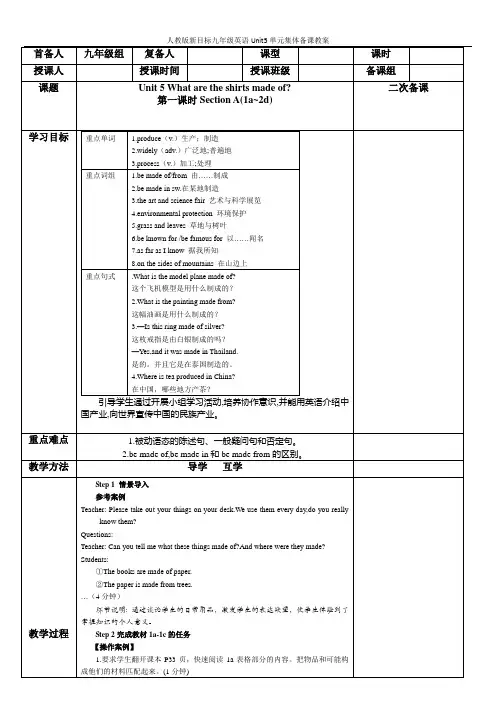
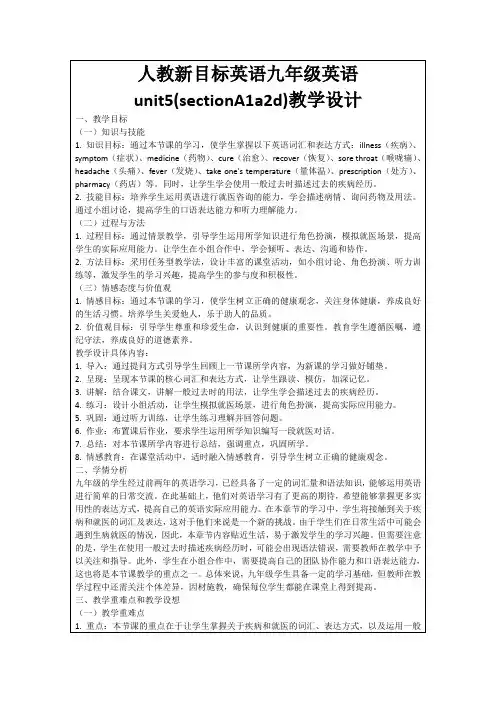

新目标九年级英语Unit 5教学设计和反思新目标九年级英语Unit 5 It must belong to Carla教学设计(Section A la——Grammar)一、教学设计思想《新课程理念》屮提到基础阶段英语课程的总体目标是培养学生的综合语言运用能力,而语言知识和语言技能是综合语言运用能力的基础。
任务型教学思想,以学生为主体,以任务为驱动,提倡学生参与、体验、感知、实践和合作探究的学习方式,在完成任务的过程中达到实现语言交际的目的。
本节课以学生学习兴趣、特点及学习水平为出发点,旨在创设一个有趣,富于启发思维的教学情景,激发学生学习兴趣,让学生快乐地投入到学习活动中,从而学习运用语言的能力。
二、教材分析与重难点本单元中心话题是“野炊”,谈论对事物的推测,主要语法是情态动词might could must can^表示推测的用法。
情态动词是一种重要的词法,只有掌握好它,才能更好地进行交际和阅读。
本节是本单元的第一节,本节的重点是使学生能运用情态动词might could must caift对物品所属进行推测,通过学习用相关信息对物主的推测来提髙学生的逻辑思维能力和推断能力。
难点是区分belong to和名词所有格表所属关系的运用。
利用反复操练的形式来突难教学难点。
三、学情分析与教法学法学习兴趣的激发和树立学习信心是很重要的。
因此,教师要创造有趣的教学情景和设计难易适宜的任务,让全班学生都能参与到活动中来,创造更多的机会让他们说英语,通过小组合作学习降低学习难度,使他们体验成功的喜悦。
我主要采用任务型教学法结合情景教学、交际教学、视听说的教学法。
四、教学目标1、知识目标a识记词汇author, picnic belong to hairband possiblyb.掌握目标语言Whose English book is this? It must be Carla's. It has her name on it..Whose volleyball is this ?It could /might be Alice's. She loves volleyball.Whose pen is this ?It might belong to Helen.Ifs under her chair.Whose T-shirt is this ?It can't be John's. It's too much small for him.2、能力目标a.学生能用情态动词并根据相关信息对物品所属进行推测。
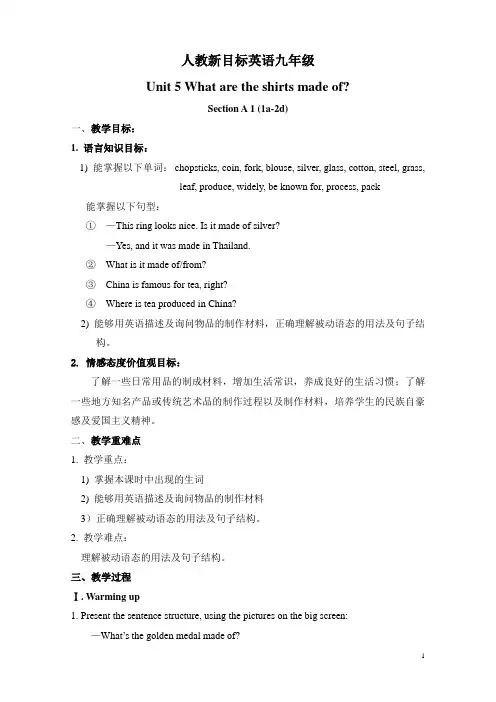
人教新目标英语九年级Unit 5 What are the shirts made of?Section A 1 (1a-2d)一、教学目标:1. 语言知识目标:1) 能掌握以下单词:chopsticks, coin, fork, blouse, silver, glass, cotton, steel, grass,leaf, produce, widely, be known for, process, pack 能掌握以下句型:①—This ring looks nice. Is it made of silver?—Yes, and it was made in Thailand.②What is it made of/from?③China is famous for tea, right?④Where is tea produced in China?2) 能够用英语描述及询问物品的制作材料,正确理解被动语态的用法及句子结构。
2. 情感态度价值观目标:了解一些日常用品的制成材料,增加生活常识,养成良好的生活习惯;了解一些地方知名产品或传统艺术品的制作过程以及制作材料,培养学生的民族自豪感及爱国主义精神。
二、教学重难点1. 教学重点:1) 掌握本课时中出现的生词2) 能够用英语描述及询问物品的制作材料3)正确理解被动语态的用法及句子结构。
2. 教学难点:理解被动语态的用法及句子结构。
三、教学过程Ⅰ. Warming up1. Present the sentence structure, using the pictures on the big screen:—What’s the golden medal made of?—It’s made of gold.—Is this table made of wood?—No, it isn’t. It’s made of glass.—Is Butter made from meat?—No. It’s made from milk.II. Presentation1. Show some pictures on the big screen. Try to learn the new words using “be made of”structure.Learn the new words: chopsticks, coin, fork, blouse, silver, glass, cotton, steel, grass, leaf2. Ss discuss with their partner and try to learn the new words.3. Give Ss five more minutes to remember the new words.4. Work on 1a:Let Ss read the things and materials in 1a. Discuss with their partners and match them with the materials. More than one answer is possible.What are these things usually made of? Match them with the materials. More than one answer is possible.Check the answers with the Ss.III. Listening1.T: Tell Ss they will hear a conversation about some things and material. Listen andmatch the products with what they are made of and where they were made.2. Let one student read the words in the box, Play the recording for the Ss to listen.3. Ss try to listen and match the things with the material and here they were made.4. Play the recording again. Let Ss answer the questions.1) How much did Susan pay for the three shirts?29 dollars.2) What does Anita feel about the three shirts?Cheap.3) What are the shirts made of?Cotton.4) Where were they made?America.5) Where did Susan buy the chopsticks?Korea.6) How does Anita like the chopsticks?Cool.7) What else does Susan show?Ring.8) Where was the ring made?Thailand.9) What will Susan do with the ring?She give it to her friend.IV. Pair work1. Read the conversation in the box in 1c.2. Ss try to made conversations using the information in 1b.e.g. A: Your new shirt looks very nice. Is it made of cotton?B: No, it isn’t. It’s made of silk.3. Let some pairs read out their conversations.V. ListeningPre-listeningfair adj. 公平的; 合理的; 美丽的fair n. an event at which people orbusinesses show and sell productsa book faira trade fairWork on 2a:T: Let’s listen to another conversation between Nick and Marcus.1. What are they talking about? First, let’s look at the pictures and the phrases in 1a.(Let one students read the phrases in 2a.)Listen and check ( √) the main topic of Nick and Marcus’ conversation.____ the science museum____ the art and science fair____ environmental protection____ a model plane____ a beautiful painting____ grass and leaves2. Play the recording for the Ss to listen and check the phrases.3. Play the recording again to check the answers.Work on 2b:1. Let Ss read the sentences below. Explain some main sentences for the Ss. Make sure they know what to do.2. Let Ss read the questions in 2b. Make sure they understand the meaning of each question.Play the recording for the Ss to answer the questions. (If necessary, using the pause button.)1) Where is the art and science fair?_________________________2) Do Nick and Marcus have to pay to go?_________________________3) What is the model plane made of?_________________________4) What is the painting made from?__________________________3. Play the recording again and mark true or false.1) The art and science fair is just inside the science museum.2) The fair is mainly about planes and paintings.3) All the works at the fair were made by university students.4) The model plane is very big.5) The painting is made of wool and grass.6) The students are asked to pay for the art and science fair.7) The students are interested in environmental protection and recycling.VI. Pair work1. Tell Ss to make a conversation using the information in 2a and 2b.e.g.A: What did you see at the art and science fair?B: I saw a model plane.A: What is it made of?B: It’s made of steel, glass, and plastic.2. Let Ss make their own conversations.3. Practice their conversations in pairs.VII. Role-play1. Work on 2dRead the conversation and complete the blanks.1) Chinese _____________ tea both in the past and now.2) _________ I know, tea plants _________ on the sides of mountains.3) When the leaves are ready, they _______ by hand and then _______ for processing.4) The tea ____________ and sent to many different countries and places around China.5) People say that tea ___________ ____ health _____ business!2. Read the conversations and Let Ss read after the teacher.3. Ask Ss to role-play the conversation in groups.VIII. Language points1. What is the model plane made of?What is the painting made from?be made of与be made from 辨析两词组都是“由……制成的”之意。
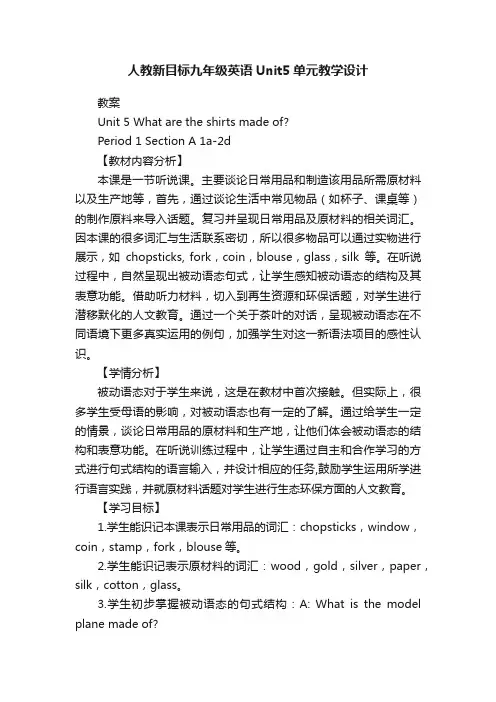
人教新目标九年级英语Unit5单元教学设计教案Unit 5 What are the shirts made of?Period 1 Section A 1a-2d【教材内容分析】本课是一节听说课。
主要谈论日常用品和制造该用品所需原材料以及生产地等,首先,通过谈论生活中常见物品(如杯子、课桌等)的制作原料来导入话题。
复习并呈现日常用品及原材料的相关词汇。
因本课的很多词汇与生活联系密切,所以很多物品可以通过实物进行展示,如chopsticks, fork,coin,blouse,glass,silk等。
在听说过程中,自然呈现出被动语态句式,让学生感知被动语态的结构及其表意功能。
借助听力材料,切入到再生资源和环保话题,对学生进行潜移默化的人文教育。
通过一个关于茶叶的对话,呈现被动语态在不同语境下更多真实运用的例句,加强学生对这一新语法项目的感性认识。
【学情分析】被动语态对于学生来说,这是在教材中首次接触。
但实际上,很多学生受母语的影响,对被动语态也有一定的了解。
通过给学生一定的情景,谈论日常用品的原材料和生产地,让他们体会被动语态的结构和表意功能。
在听说训练过程中,让学生通过自主和合作学习的方式进行句式结构的语言输入,并设计相应的任务,鼓励学生运用所学进行语言实践,并就原材料话题对学生进行生态环保方面的人文教育。
【学习目标】1.学生能识记本课表示日常用品的词汇:chopsticks,window,coin,stamp,fork,blouse等。
2.学生能识记表示原材料的词汇:wood,gold,silver,paper,silk,cotton,glass。
3.学生初步掌握被动语态的句式结构:A: What is the model plane made of?B:It’s made of used wood and glass.4.学生能够树立生态环保意识,简单了解中国的茶文化。
【学习重点】学会使用被动语态表达被动关系。
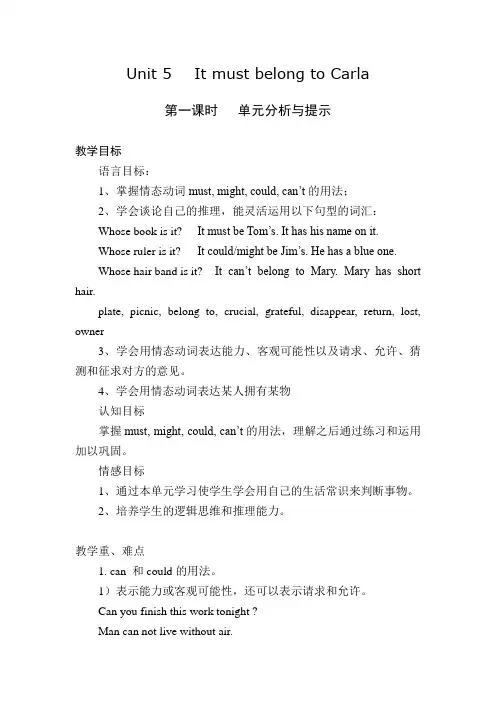
Unit 5 It must belong to Carla第一课时单元分析与提示教学目标语言目标:1、掌握情态动词must, might, could, can’t的用法;2、学会谈论自己的推理,能灵活运用以下句型的词汇:Whose book is it? It must be Tom’s. It has his name on it.Whose ruler is it? It could/might be Jim’s. He has a blue one.Whose hair band is it? It can’t belong to Mary. Mary has short hair.plate, picnic, belong to, crucial, grateful, disappear, return, lost, owner3、学会用情态动词表达能力、客观可能性以及请求、允许、猜测和征求对方的意见。
4、学会用情态动词表达某人拥有某物认知目标掌握must, might, could, can’t的用法,理解之后通过练习和运用加以巩固。
情感目标1、通过本单元学习使学生学会用自己的生活常识来判断事物。
2、培养学生的逻辑思维和推理能力。
教学重、难点1. can 和could的用法。
1)表示能力或客观可能性,还可以表示请求和允许。
Can you finish this work tonight ?Man can not live without air.2)could也可表示请求,语气较委婉,主要用于疑问句,不可用于肯定句,答语应用can,否定用No,I’m afraid not.Could I come to see you tomorrow ? Yes, you can; No, I’m afraid not3)当表达“某件事已成功”时应用was(were) able to,而不能用couldHe was able to go to the party yesterday evening and he enjoyed himself very much.4)表示惊异、怀疑、不相信的态度(主要用于否定句、疑问句或感叹句)2. may的might的用法3. shall和should的用法4. must 的否定回答用needn’tmay的否定回答用mustn’tMust I hand in my paper today ?No, you needn’t.May I keep this novel for three weeks ?No, you mustn’t教学安排4课时第一课时:Section A 1a, 1b, 1c, 2a, 2b, 2c第二课时:Section A 3a, 3b, 4第三课时:Section B 1, 2a, 2b, 2c, 3a第一课时:Section B 3b, 3c, 4 and Self CheckUnit 5 第二课时Teaching aims本课学会用情态动词表达物品的所有者Teaching of new lesson1、Ask four students to take out the things they broughtjacket, T-shirt, CD, toy car1) Ask the other studentsT: whose jacket is this ? S: Anna’s ?T: I think it could be Anna’s. It might be Anna’s. Let’s ask her. Anna, is this your jacket?S2: No, it’s not mine. It must be Lee’sT: It can’t be Anna’s. it must belong to Lee.2) Ask the students to practice the dialogue with T-shirt, CD, toy carA: Whose … is this?B: Tom’sA: I think it could be Tom’s. It might be Tom’s. Let’s ask him. Tom, is this your …… ?C: No, it’s not mine. It must be John’sT: It can’t be Tom’s. It must belong to John.3) Say: When we talk about things we’re not sure of, we use the words: could, might, can’t and must. And pay attention to the words “belong to John”, don’t say “belong to John’s”2. Point to the picture and ask:Which items in the picture do you know ?Which items are new to you ?Clothing: hat, jacket, T-shirt.Fun things: volleyball, CD, toy car, magazine, bookKitchen things: plate, cups3. Ask the students to connect the items in the three column Section A, 1b.先让学生听第一遍,按要求完成1b,更正答案J ane’s little brother - toy car --- He was the only little kid at the picnic.Mary – book - Wanda Wilbur is her favourite author.Carla – volleyball - She loves volleyballDeng Wen-magazine- He loves cats.Grace – CD – She always listens to classical music.4. Ask the students to practice using the target language.Whose, volleyball, toy car, magazine, book, CD, must be, belong to5. 2a. This activity provides listening practice using the target language.a school T-shirt, a hair band, tennis balls.Kumi’s, Linda’s, Rita’s6. 2b. This activity provides listening and writing practice using the target language written by the teacher.Must might could or can’t7. Extension利用各种各样的实物或图片,模仿听力的对话模式,让学生进行各种猜测。
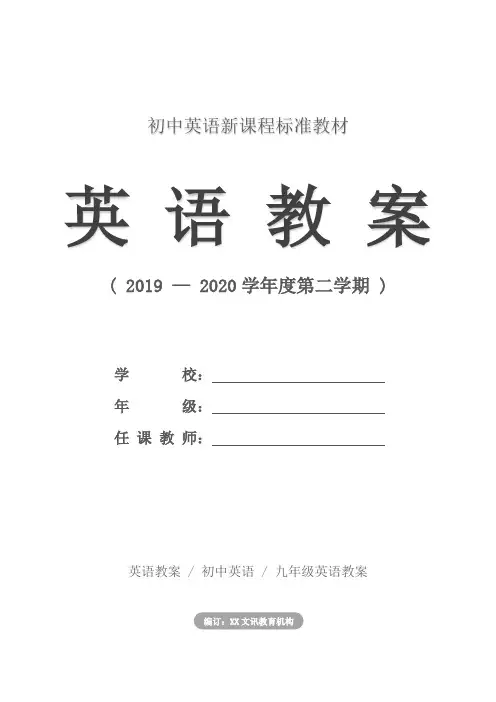
初中英语新课程标准教材英语教案( 2019 — 2020学年度第二学期 )学校:年级:任课教师:英语教案 / 初中英语 / 九年级英语教案编订:XX文讯教育机构新目标九年级英语第五单元教案教材简介:本教材主要用途为通过学习英语的内容,提高学生的语言技能,增加一项语言能力,有利于国际化的日常交流、生活、工作等,本教学设计资料适用于初中九年级英语科目, 学习后学生能得到全面的发展和提高。
本内容是按照教材的内容进行的编写,可以放心修改调整或直接进行教学使用。
unit 5 it must belong to carla.(共5课时)教学目标:1知识与技能:本单元通过学习情态动词,学会正确运用must,might,could和can’t对事物进行推测,并注意体会这些词表示判断时的程度,尽量做到用词准确,拓展了belong to,much too,too much 等词的使用,并提供了一些实用的英语谚语。
要对本单元中的生词做到会读,会写,会用。
2学习策略归纳总结情态动词can,may,must表推断的用法,比较它们的用法区别。
在选择它们进行运用时,要多角度,全方位地思考,根据句子语境明确句子的含义,选择正确的情态动词。
3,情感态度与价值观在日常生活中我们要善于动脑观察,比较事物的特点与区别,逐渐培养自己的推理、判断能力。
同时要学会对某一事物发表自己的看法并申明理由,进而锻炼自己的演讲口才以及与人交往的能力。
教学重点:1belong to 短语的应用2情态动词表推测判断的用法。
3重点词汇的学习,掌握运用。
教学方法:pairwork groupwork 教学难点:1 have 与there be 结构的区别运用 2 because与because of 区别课时安排:本单元需用5课时完成。
the 1st lessonstep 1 lead in teacher’s activitystudents’ activity批注show a backpack to everyone.ask ss to guess “whose backpack is this?”guess with “it could be …’s. it must be …’s.”启发式教学help them to guess with “it could be …’s,because….”say:itmust be ...’s.look,here’s her name.” today,let’s learn unit5 it must belong to carla.listen and try to understand.step2 1a,1b look at the picture and finish 1acheck and explain “plate”read the sentences in the picture.explain “whose is this volleyball?”listen and take notes.play the record for the first time.listen and finish 1b. if necessary,listen again.锻炼学生听力check the answers.read the sentences one by one .step3 pairwork. read 1cwalk around the classroom,help them if they need.practice the conversation in the picture and make conversations with your partner.两人一组练习act it out in class.step4 2a,2b,2c play the record first time.listen and finish 2a.if necessary, play again.if necessary,listen again.提高听力能力check the answers.in the same way,finish 2b and check the answer.finish 2c.check the answers and explain something important.read “grammar focus”.explain something important.step5 homework. 与你的好友推断附近得某物品是谁的,然后互相练习。

初中英语九年级 Unit 5 Section A (2a-2d)教学设计一. 教材分析本课选自人教版《新目标》初中英语九年级Unit 5 Section A (2a-2d)。
本部分内容主要讲述关于不同国家节日的话题。
通过本节课的学习,学生能够了解和掌握与节日相关的词汇和表达方式,提高他们的听说读写能力。
二. 学情分析九年级的学生已经具备了一定的英语基础,对于日常生活中的话题有了一定的了解。
但部分学生对于表达自己观点仍存在一定的困难,因此,在教学过程中,教师需要关注这部分学生的需求,鼓励他们积极参与课堂活动。
三. 教学目标1.知识目标:学生能够掌握与节日相关的词汇和表达方式。
2.能力目标:学生能够运用所学知识进行简单的交流,提高听说读写能力。
3.情感目标:培养学生对于不同文化的尊重和理解。
四. 教学重难点1.重点:学生能够掌握与节日相关的词汇和表达方式。
2.难点:学生能够运用所学知识进行实际交流。
五. 教学方法采用任务型教学法,通过小组合作、角色扮演等方式,激发学生的学习兴趣,提高他们的参与度。
同时,教师应给予学生足够的鼓励和支持,帮助他们克服表达障碍。
六. 教学准备1.教师准备相关节日的图片、视频等教学资源。
2.学生准备笔记本,用于记录所学内容。
七. 教学过程1.导入(5分钟)教师通过展示不同国家的节日图片,引导学生谈论各自了解的节日,激发学生的学习兴趣。
2.呈现(10分钟)教师呈现2a的内容,让学生听录音并回答问题。
然后,学生两人一组,互相练习2a的对话。
3.操练(10分钟)学生分角色扮演2a的对话,教师巡回指导,纠正发音和表达错误。
4.巩固(10分钟)学生小组合作,根据2a的对话,编写类似的对话,并表演给其他小组观看。
5.拓展(10分钟)教师引导学生讨论不同国家的节日风俗,鼓励学生分享自己的经历。
6.小结(5分钟)教师总结本节课所学内容,强调重点词汇和表达方式。
7.家庭作业(5分钟)学生回家后,用所学知识写一篇关于自己喜欢的节日的短文。
第一课时Sect i on A(1a~2d)1.produce(v.)生产;制造2.wide ly(adv.)广泛地;普遍地3.process(v.)加工;处理8.on the s ides o f mount a ins在山边上.What i s the model p lane made of?这个飞机模型是用什么制成的?2.What i s the pa in t ing made f rom?这幅油画是用什么制成的?3.—Is th i s r ing made of s i lver?这枚戒指是由白银制成的吗?—Yes,and i t was made in Tha i land.是的。
并且它是在泰国制造的。
4.Where i s t ea p roduced in China?在中国,哪些地方产茶?Teacher: P lease t ake out your th ings on your desk.We use them every day,do you rea l ly know them?Ques t ions:教学过程Step 2完成教材1a-1c的任务5.小结训练。
要求学生在规定的时间内完成一个小练习。
并请若干学生给出自己的答案。
有错误的话及时纠正。
(2分钟)用括号内所给动词的正确形式填空。
1)The apples a re sen t(send)to the fac tory f or p rocess ing.2)We are a l l r eady bu t Tom hasn’t packed (pack) h i s c lo thes ye t.3)The windows of the room are c leaned(c lean)every day.4)The bes t co t ton i s p r oduced(p roduce)in Xing J iang in China.5)The song isn’t liked (no t l ike) by mos t o f us.环节说明:通过学习1a,使学生对被动结构有所了解;通过1b,锻炼学生的听力及抓取关键信息的能力;通过1c的训练锻炼学生的口头表达能力,同时巩固对一般现在时被动结构的认识。
英语九年级上册第五单元教学案执笔人:曾碧云Section A第一课时一、课前预习1. 从课本中查出下列单词的中文意思并抄写5次。
belong (________) _________________________________________________ author (________) _________________________________________________ picnic (________) __________________________________________________ possible (________) _________________________________________________ hair band (________) _________________________________________________ classical (________) _________________________________________________ 2. 归纳出所有你曾经学过的情态动词并写出它们的汉语意思。
如:can 能、_____________________________________ ______ ______________________________ ____ 3. 用适当的动词及情态动词填空。
1) He can swim well, but I ________.2) My daughter is ill. I ________take care of her.3) You must be a writer, ________you?4) Your shoes are so dirty. _________ I wash them for you?5) _______you get on well with your classmates?6) Aunt Li started early. She _______ be in the city now.7) –Peter _______ have been hurt in the car accident.4、学习现在完成时态⑴由have/ has +过去分词⑵表示过去发生或已经完成的某一动作对现在造成的影响或结果常与already, just , yet , ever, never 连用Have you finished your work yet?你完成了你的工作了吗?Yes, I have. I have just finished it.是的。
Unit 1 How do you study for a testSection A1. How do you study for a test? 你怎样为考试做准备?2. by 1)通过…..方式(途径)。
(by doing sth 通过做某事)例:I learn English by listening to tapes. 2)在…..旁边。
例:by the window/the door 3)乘坐交通工具例:by bus/car4)在……之前,到……为止。
例:by October在10月前5)被例:English is spoken by many people.6) 由于by mistake 7) 连接one by one 一个接着一个3. ask:1) ask sb (not)to do sth .请某人(不要)做某事2) ask sb about sth .询问某人关于某事He asked me about the meeting.3) ask for…. 请求/要……如:I’ll ask for two days off. 我将请两天假。
4) ask sb for sth 向某人请求/要某物ask the teacher for help 向老师求助4. practice doing 练习做某事She often practice speaking English. 她经常练习说英语。
5. What/ how about +doing sth.? 做某事如何?6. aloud / loudly / loud1)aloud: adv,强调发出的声音能被听见,意为“出声地”或“大声地”,常与read,call连用,无比较级和最高级。
He read the story aloud to his son.他朗读那篇故事给他儿子听。
2)loud: adj/adv “响亮的/地;大声的/地;高声地”,侧重发出的声音大,传得远。
Unit 5 It must belong to Carla.Ⅰ. Analysis of the Teaching MaterialStatus and FunctionThe topic of this unit is a picnic, In this unit, students learn to make inferences.Such topic is helpful to activate students’imagination and improve students’ability to deduce. Either less or more advanced students will be active in the activities in class. So it’s useful to improve students’ spoken English and communicative competence.(1) The first period mainly introduces the key vocabulary and the target language to students. Through listening and oral practice, students have a brief understanding of how to make inferences.(2)In the second period, students learn the exact meanings of the words must, might, could and can’t.Meanwhile, students practice listening and writing the target language.(3) When reading an article, students can’t help meeting with some new words. In the third period, students are asked to practise using the target language by talking about the new words, It’s helpful to arouse students’ learning interest and improve students’ listening and speaking skills. (4) The fourth period gives students further listening and oral practice using the target language by talking about an alien is chasing a man.In this class, students have a better understanding of the words must, might, could and can’t. (5) In the fifth period, students learn more vocabulary words first, and then practice reading and writing the target language. All the activities are designed to improve students’ reading and writing skills.(6)In the last period, students learn a lot of proverbs. Proverbs are full of truth and advice. Students will benefit a lot in this class.2. Teaching Aims and Demands(1) Knowledge ObjectsIn this unit, students learn to make inferences using the words must, might, could and can’t. (2) Ability ObjectsTo train students’ listening, speaking, reading and writing skills.To train students’ ability to deduce.(3) Moral ObjectsWhen you are on a picnic, remember to bring litter back to keep our environment clean and tidy. We’ll benefit a lot by learning proverbs.3. Teaching Key PointsTo learn the key vocabulary words and the target language.To learn to make inferences using the words must, might, could and can’t.4. Teaching Difficult PointsTo train students’ listening, speaking, reading and writing skills.To enable students to grasp the usage of must, might, could and can’t.5. Studying WayTeach students how to make inferences using must, might, could and can’t.Ⅱ. Language FunctionMake inferencesⅢ. Target LanguageWhose volleyball is this?It must be Carla’s. She loves volleyball.It could be Ted’s.Ⅳ. Structuremust, might, could and can’tⅤ. Vocabularypicnic, chase, escape, belong to, toy car, plate’, mystery, appointment, worried, wake, neighbor, garbageⅥ. Recyclingsuit, land, volleyball, magazine, book, CD, bat, earring, T-shirt, UFO, whose, owner, exercise, dream, anxiousⅦ. Learning Strategies1. Sequencing2. DeducingⅧ. Teaching TimeSix periodsThe First PeriodI. Teaching Aims and Demands1. Knowledge Objects(1) Key V ocabularybelong, belong to, plate, author, toy, picnic(2)Target LanguageWhose book is this?It must be Mary’s. Wanda Wilbur is her favourite author.2. Ability Objects(1) Train students’ listening skill.(2) Train students’ communicative competence using the target language.3. Moral ObjectsWhen you are on a picnic, remember to bring litter back to keep our environment clean and tidy. Ⅱ.Teaching Key Points1. Key vocabulary2. Target languageⅢ.Teaching ProceduresStep I RevisionCheck homework. Invite different students to say the answers to the exercises on pages 12~14 of the workbook.Step Ⅱ1aThis activity introduces the key vocabulary.Write the key vocabulary words on the blackboard. Say the words one by one and have students repeat several times until they can read them fluently and accurately.Ask different students to explain in their own words the meanings of the words belong to, author and picnic.Belong means to be owned by somebody.An author is a writer of a book or a play.A picnic is a meal eaten out of doors.Then invite two students to draw a plate next to the word plate and a toy car next to toy.Focus attention on the picture. Have students point to each item and say its name. Call students attention to the chart with the headlines clothing. Funthings and kitchen things at the top. Invite different students to explain the meanings of the column heads.Say, Please look at the picture and write the things you see in the correct columns in the chart. Point out the sample answers. Get students to complete the task on their own. As they work, move around the room checking their progress and answering any questions they may have.Show the correct answers on the screen by a projector.Step ⅢlbThis activity gives students practice in understanding the target langugage in spoken conversation. Call students’ attention to the chart. Set a time limit of two minutes. Students read the persons, the things and the reasons.Say, You will hear a conversation. As you listen, draw lines to connect the person in the first column with the thing in the second column. Then draw another line to connect the thing in the second line with the reason in the third column.Point out the sample answer. Say, The name Carla in the first column connects to volleyball in the second column because that’s the thing they are talking about. And the word volleyball in the second column connects with the sentence she loves volleyball in the third column.Play the recording the first time.Students only listen. Play the recording again. This time students listen and match each person with a thing and a reason.Check the answers.Step Ⅳ1cThis activity provides oral practice using the target language.Point to the picture in Activity lb. Invite pair of students to say the conversation in the speech bubbles.Point out the conversation in the box. Invite another pair of students to say it to the class. S A : Whose book is this?S B: It must be Mary’s. Wanda Wilbur is her favourite author.Write the conversation on the blackboard.Point out the chart in Activity 1b. Say.Now work with a partner. Start by reading the conversations in the picture and in the box: Then make conversations using the information in the chart in Activity 1b. Talk about who each thing might belong to and give a reason. Get students to practice in pairs. As they work, move around the classroom listening in on various pairs and offering help with language and pronunciation as needed.After all the students have had an opportunity to ask and answer questions, stop the activity. Get different pairs of students to say their conversations to the class.Step ⅤSummarySay, In this class, we’ve learned the key vocabulary words belong to, plate, author, toy and picnic and done much listening and oral practice using the target language.Step ⅥHomework(1) Say and remember the spelling of the vocabulary words.(2)Say the conversations in Activity 1c to get a further understanding of the target language.Unit 5 It must belong to Carla.The Second PeriodI. Teaching Aims and Demands1. Knowledge Objects(1) Key V ocabularydrop, symphony, optometrist, appointment, algebra, crucial, count, because of, Chinese-English dictionary, Oxford University(2) Target LanguageWhat do you think "anxious" means?Well, it can’t mean "happy".It might mean "worried".Oh, yes, she is worried because of her test.Here are some earrings. The owner can’t be a boy.Well, it could be a boy. The earrings might be a present for his mother.2. Ability Objects(1) Train students’ reading skill.(2) Train students’ communicative competence using the target language.Moral ObjectWhen you are in trouble, send an e-mail message to your friends to ask for help.Ⅱ. Teaching Key Points1.Reading practice2.Oral practice using the target languageⅢ. Teaching Difficult Points1. Key vocabulary2. Target languageⅣ. Teaching ProceduresStep I RevisionRevise the usage of the words must, might, could and can’t by checking homework.Ask students to exchange their exercises books and help correct any errors with each other, As they are doing this, move around the classroom offering language support as needed. Then invite different students to say their sentences to the class.Step Ⅱ3aThis activity provides reading practice using the target language.Call students’attention to the picture.Ask students to tell what’s happening in the picture.T: What’s the girl doing?S s: She is using the computer to write e-mail.Point to the parts of the e-mail message.Tell students that this is the message the girl in the picture writes. Say, Right now the parts are in the wrong order. When they are in the right order, they will make a clear message. Now please read the parts carefully. Number them in order. When you are doing this, you will meet with some words you don’t know.Don’t worry too much about them. Just circle them. We’ll talk about what they mean later.Get students to complete the task on their own. Point out the sample answer.Say. The first sentence of the e-mail message is I’m really anxious, because I can’t find my backpack.Check the answers.Step Ⅲ3bThis activity provides oral practice using the target language.Read the instructions to the class. Point to the sample conversation. Invite a pair of students to say it to the class.S A: What do you think "anxious" mean? S B: Well, it can’t mean "happy".S A: It might mean "worried". S B: Oh, yes. She is worried because of her test.Write the conversation on the blackboard.Say, You are to talk about the circled words in Activity 3a. Use the words can’t, must, could or might as in the sample.Get students to work with a partner. As they work in pairs, move around the classroom helping students with pronunciation and answering any questions they may have. Some time later, stop the activity. Ask different students to share their conversations with the class. Make a list of the words students are talking about on the blackboard.Practice the pronunciation of these words and explain the meaning of each word. Step ⅣPart 4This activity provides oral practice using the target language.Call students’ attention to the picture. Get students to name each item in it.Write the new words Chinese-English dictionary and Oxford University on the blackboard. Point to the sample conversation. Invite a pair of students to read it to the class.Write the conversation on the black board. Explain the meaning of each sentence. Focus attention on the chart with the headlines Can’t, Could/might and Must at the top. Point out the sample answer.Read the instructions to the class.Get students to complete the task in pairs. As the pairs work together, move around the classroom helping students with pronunciation, sentence formation or anything else they ask for help with.Ask some pairs to say their conversations to the class.Note: Answers to the chart will vary.Step ⅤSummarySay, In this class, we’ve learned some vocabulary words, such as drop, symphony.And we’ve done much oral practice using the target language.Step ⅥHomework1. Read the letter in Activity 3a again for further understanding of the vocabularywords.2. Read the conversations in Activities 3b and 4 again for further understanding of the target language.3. Finish off the exercises on pages 15~16 of the workbook.The Third PeriodI. Teaching Aims and Demands1. Knowledge Objects(1) Key Vocabulary:chase, creature(2) Target LanguageWhy do you think the man is running?He could be running for exercise.No, he’s wearing a suit. He might be running to catch a bus.2. Ability Objects(1)Train students’ listening skill.(2)Train students’ writing skill.3. Moral ObjectThe UFO and alien are both unreal. As students, we must work hard to explore the universe in the future.Ⅱ. Teaching Key Points1. Listening practice2. Writing practiceⅢ. Teaching Difficult Points1. Write a sentence about each picture.2. Write two or three sentences to finish the story.3. Listen and complete the sentences.Ⅳ. Teaching ProceduresStep ⅠRevision1. Invite a student to read the thank you message Linda wrote to Anna to the class.2. Get different pairs of students to read the conversations in Activities 3band 4.3. Check answers to the exercises on pages 15~16 of the workbook.StepⅡPart lThis activity provides writing practice using the target language.Read the instructions to the class. Read the words in the box and have students repeat several times. Invite different students to explain the meaning of each word in their own words.Get students to look at the three pictures carefully. Say, You are to use the words from the box to write a sentence about each picture. Point out where to write the sentences. Ask a student to say the sample answer to the class. Get students to complete the activity individually. As students work, walk around the classroom offering language support as needed.Check the answers on the blackboard.Step Ⅲ2aThis activity gives students practice understanding and writing the target language in spoken conversation.Read the instructions to the class. Point to the three pictures in Activity 1. Say, You will hear a conversation about these pictures. As you listen, write a number in the box in the left corner of each picture to show the order of the events.Point out the sample answer in the box of the third picture. Say, You will hear the man is running first. Play the recording the first time. Students only listen. Play the recording again. This time students listen and number the pictures. Encourage students to write two or three sentences to finish the story.Answers will vary. Write a sample version on the blackboard. Ask students to use it as a model.Step Ⅳ2bThis activity gives students practice listening to and writing the target language.Point to the chart with sentence startersThey see …The man says…and The woman says…Say, You are to listento the same recording again. And complete each sentence.Point out the sample answers. Say, They see a man running. The man says he could be running for exercise. The woman says he might be late for work. Explain the meaning of the word creature to the students.Play the recording once or twice, using the Pause button as necessary.Show the answers on the screen by a projector so thatStep Ⅴ2cThis activity provides oral practice using the target languagePoint out the sample conversation in the box. Invite a pair of students to read it to the class.S A: Why do you think the man is running?S B: He could be running for exercise.S A: No, he’s wearing a suit. He might be running to catch a bus.Write it on the blackboard.Say, Now work with a partner. Start by reading the conversation in the box with your partner. Then role play conversations using information in Activity 2b.Get students to work in pairs. As the pairs work together, walk around the classroom listening in on various pairs and offering help needed. Ask several pairs to say their conversations to the class.Step ⅥSummarySay, In this class, we’ve mainly done much listening and writing practice using the target language.Step ⅦHomeworkAsk students to collect pictures of different kinds and then talk about them using must, could, might and can’t.The Fourth PeriodI. Teaching Aims and Demands1. Knowledge Objects(1) Key Vocabularyextremely, worried, neighbor, garbage, mystery, director, escape, ocean(2) Target LanguageIn my dream, I was swimming in an ocean of paper.Maybe it means you’re afraid of too much homework!2. Ability Objects(1) Train students’ reading skill. (2) Train students’ writing skill.(3) Train students’ integrating skills.3. Moral ObjectEveryone has had a dream. But don’t dream away your time.Ⅱ. Teaching Key Points1. Key vocabulary2. Reading practice3. Writing practiceⅢ. Teaching Difficult Points1. Reading practice2. Writing practiceⅣ. Teaching ProceduresStep ⅠRevisionCheck homework.Collect pictures from students on the teacher’s desk. Hold up one at a time and ask students to describe it using the target language introduced in the preceding classes. For example:T: (Holding up a picture with a boy swimming in an ocean of books) What do you think is happening to the person in the picture?S1: He must be a student. S2: He could be having a dream. S3: He might like reading books. Step Ⅱ3aThis activity provides reading practice using the target language.Show the key vocabulary words on page 38 on the screen by a projector.Say the words one by one and have students repeat several times until they can pronounce them fluently and accurately. Read the title of the newspaper article strange events in Bell Tower neighborhood to the class. And then point to the picture and ask students. How is the person feeling? Help students to answer. He is confused and upset.Call students’ attention to the article. Read it to the class. Say, Now please read the article individually and underline what people think could be causing the strange things that are happening in Bell Tower. Point out the sample answer.Get students to complete the task individually. As they work, walk around the classroom answering any questions they may have and offering help as needed. Check the answers.Answersan animal, teenagers, the wind, a dogStep Ⅲ3bThis activity provides reading and writing practice using the target language.Get students to discuss any words or sentences they don’t know in Activity 3a with one another. Call students’attention to the three sets of notes. Ask different students to read them to the class.Chu family--late night footsteps in the hallway--might be the neighborsLao Zheng--someone trying to get in the window--might be the windXiao Ning--finds garbage in front of her house--might be catsSay, You are to write another paragraph about Bell Town using these notes. You may use the article inActivity 3a as a model. Ask students to write their paragraphs on their own in the exercise books. As they work, move around the classroom offering language support as needed. Get a few students to read their works to the class. Answers will vary. Write the sample version on the blackboard.Step Ⅳ3cThis activity provides writing practice using the target language.Read the title No more mystery in Bell Tower neighborhood to the class and explain the meaning of the word mystery. Invite a student to read the opening sentences to the class. Divide the class in to groups of four to discuss what should be included in the article.Two or three minutes later, stop the activity. Say, Now please finish the article about the strange events in Bell Tower. Use the ideas you discussed along with original ideas of your own to complete the article. Get students to complete the task on their own in the exercise books. As they are writing, move around the classroom offering help as needed. Ask some students to read their articles to the class.Collect students’ works and write a comment on each paper before returning them.Step ⅤPart 4This activity provides reading, writing, listening and speaking practice using the target language. Read the instructions to the class. Point to the picture. Ask students to tell what is happening in it. Invite a pair of students to read the sample conversation in the box to the class.Say, Once I had a dream. In my dream, I was eating a state dinner. What might the dream mean? Students may answer.Maybe it means you are too hungry. Say. Think of a dream you had recently and tell your classmates about it Your classmates guess what the dream might mean. Please work with a partner. Start practice by reading the sample conversation. As the pairs work together, walk around the room offering help with pronunciation and language. Ask different pairs to tell the class about their dream and what they may mean.Step ⅥSummarySay, In this class, we’ve mainly done much reading and writing practice using the target language. We’ve learned some vocabulary words as well.Step ⅦHomework1. Reread the newspaper article in Activity 3a.2. Review the paragraph in Activity 3b,The Fifth PeriodI. Teaching Aims and Demands1. Knowledge Objects(1)Key Vocabularyfinger, stone, ant, poor, dishonest, bark, wake, pretend, use up, attempt(2)Fill in blanks and make sentences using vocabulary words.(3)Learn some proverbs.(4)Circle the word that doesn’t belong.2. Ability Objects(1)Train students’ writing skill.(2)Train students’ ability of reading comprehension.(3)Train students’ ability of clarifying.3. Moral ObjectWe’ll benefit a lot by learning proverbs.Ⅱ. Teaching Key Points1. Make sentences using vocabulary words.2. Say the meanings of different proverbs in your own words.3. Circle the word that doesn’t belong.Ⅲ. Teaching Difficult Points1. Make sentences using vocabulary words.2. Say the meanings of different proverbs in your own words.Ⅳ.Teaching ProceduresStep ⅠRevisionAsk several students to read the newspaper article in Activity 3a to the class.Step ⅡPart 1This activity provides a comprehensive review of vocabulary presented in the unit.of the word, for example adjusting for tense or subject/verb agreement.Ask students to fill in the blanks on their Own.Check the answers. Five students each read a sentence, filling in the blanks. The rest of the students check their answers.Answers1. favourite2. careful3. anxious4. worried5. strangeAsk students to make their own sentences with the words, preferably sentences that are meaningful. Move around the room. Collect a few students’answers with mistakes on the blackboard.Help correct the mistakes.Sample answers1. What’s your favourite song?2. Be careful while crossing a road.3. We are anxious for his safety.4. You don’t have to be worried about me.5. I had a strange dream last night.Step ⅢPart 2This activity provides reading, writing, listening and speaking practice using the target language. Show the vocabulary words on the screen by a projector.Say the words and have students repeat them until they can pronounce them fluently and accurately. Read the instructions to the class. Explain to the students that a proverb is a short well-known saying that states a general truth or gives advice.Read the first proverb to the class. One finger cannot lift a small stone. Elicit the interpretation from the students(It’s better to have help to do even small jobs).Say, Please read the proverbs, Discuss with your classmates what they might mean.Get students to work in groups of four.As the groups work together, walk around the room to make sure that students are discussing the topic in English. Invite different students to say what they think each proverb means.There can be more than one interpretation for each proverb. Check the answers by showing the sample answers on the screen by a projector.Step ⅥPart 3This activity focuses on the new vocabulary introduced in this unit.Ask students to read the five lines of words in the box.Point out the first line. In this line, escape, chase and run are all verbs. However, the word owner is a noun. So we circle it. Now please circle the word that doesn’t belong in each line.Get students to complete the task on their own. As they are doing this, move aroundthe classroom checking their progress and offering help as needed.Check the answers by asking a student to read his or her circled words to the class. Answers :1. owner 2. alien 3. land 4. exercise 5. lostStep ⅤJust for Fun!This activity provides reading and speaking practice with the target language.Ask all the students to read the cartoon story. Ask students why it is funny. Help students to answer. The boys think they are going to land on an island. Instead, they have landed on the back of a whale.Step ⅥSummarySay. In this class, we’ve practiced filling in blanks and making sentences with some vocabulary words introduced in this unit. And we’ve learned several proverbs.StepⅦHomework(1) Read and remember the proverbs learned in Activity 2.(2) Each student collects ten proverbs.(3) Finish off the exercises on pages 16~17,of the workbook.Step Ⅷ。
新目标九年级英语第五单元教案
Unit 5 It must belong to Carla.(共5课时)
教学目标:
1知识与技能:本单元通过学习情态动词,学会正确运用
must,might,could和can’t对事物进行推测,并注意体会这些词表示判断时的程度,尽量做到用词准确,拓展了belong to,much too,too much 等词的使用,并提供了一些实用的英语谚语。
要对本单元中的生词做到会读,会写,会用。
2学习策略归纳总结情态动词can,may,must表推断的用法,比较它们的用法区别。
在选择它们进行运用时,要多角度,全方位地思考,根据句子语境明确句子的含义,选择正确的情态动词。
3,情感态度与价值观在日常生活中我们要善于动脑观察,比较事物的特点与区别,逐渐培养自己的推理、判断能力。
同时要学会对某一事物发表自己的看法并申明理由,进而锻炼自己的演讲口才以及与人交往的能力。
教学重点:
1belong to 短语的应用2情态动词表推测判断的用法。
3重点词汇的学习,掌握运用。
教学方法:Pairwork Groupwork 教学难点:1 have与there be 结构的区别运用2 because与because of 区别课时安排:本单元需用5课时完成。
The 1st lesson
Step 1 Lead in
Step5 Homework. 与你的好友推断附近得某物品是谁的,然后互相练习。
板书设计:
The 2nd lesson Step1 Warm up.
Step 3 Pairwork.
Step 4 Homework. 实践活动:与你得同桌或好友就你周围得人或物进行推断并说明理由,看谁得判断能力强。
板书设计:The 4th
Step 5 Homework. 把你听到或看到得事情讲述出来,并与你得伙伴一起猜是什么?板书设计:
The 5th lesson Step 1 Pairwork.
Step4 Homework. 板书设计。